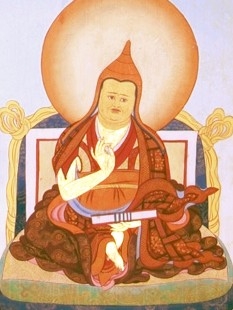Beacon of Certainty: Difference between revisions
Jump to navigation
Jump to search
mNo edit summary |
mNo edit summary |
||
| Line 2: | Line 2: | ||
'''Beacon of Certainty''' (Tib. ''Ngeshé Drönmé''; [[Wyl.]] ''nges shes sgron me'') — a text by [[Mipham Rinpoche]]. It was composed by Jamgön Mipham Rinpoche at the age of seven<ref>According to [[Khenpo Jikmé Phuntsok]] and [[Troshul Jamdor]].</ref>. Definitive knowledge needs to be arrived at in order to attain the fruit of the path. In this text the young Mipham answers seven questions going through the different approaches of the diverse traditions of Tibetan tradition, in order to bring about this definitive knowledge. | '''Beacon of Certainty''' (Tib. ''Ngeshé Drönmé''; [[Wyl.]] ''nges shes sgron me'') — a text by [[Mipham Rinpoche]]. It was composed by Jamgön Mipham Rinpoche at the age of seven<ref>According to [[Khenpo Jikmé Phuntsok]] and [[Troshul Jamdor]].</ref>. Definitive knowledge needs to be arrived at in order to attain the fruit of the path. In this text the young Mipham answers seven questions going through the different approaches of the diverse traditions of Tibetan tradition, in order to bring about this definitive knowledge. | ||
While giving insight into the key points of view and meditation on the level of [[madhyamaka]] | While giving insight into the key points of view and meditation on the level of [[madhyamaka]] and tantra, the main purpose of this text is to elucidate the teachings of [[Dzogchen]]<ref>John W. Pettit, ''Mipham's Beacon of Certainty: Illuminating the View of Dzogchen, the Great Perfection Studies in Indian and Tibetan Buddhism'' (Boston: Wisdom Publications, 1999), page 5.</ref>, and the introduction to [[Khenpo Kunpal]]'s commentary reads: | ||
:This ''Precious Beacon of Certainty'' is like an eye that brings all the difficult points of [[sutra]] and [[tantra]] into focus. Externally, it accords with [[Prasangika]]; internally, it accords with the ''[[Sutra that Gathers all Intentions]]'' (Tib. ''Gongpa Düpé Do'' ; Wyl. ''dgongs pa ’dus pa’i mdo'') and the ''[[Guhyagarbha Tantra]]''; secretly, it accords with the [[Great Perfection]]<ref>Ibid. page 128</ref>. | :This ''Precious Beacon of Certainty'' is like an eye that brings all the difficult points of [[sutra]] and [[tantra]] into focus. Externally, it accords with [[Prasangika]]; internally, it accords with the ''[[Sutra that Gathers all Intentions]]'' (Tib. ''Gongpa Düpé Do'' ; Wyl. ''dgongs pa ’dus pa’i mdo'') and the ''[[Guhyagarbha Tantra]]''; secretly, it accords with the [[Great Perfection]]<ref>Ibid. page 128</ref>. | ||
Revision as of 14:31, 13 July 2010

Beacon of Certainty (Tib. Ngeshé Drönmé; Wyl. nges shes sgron me) — a text by Mipham Rinpoche. It was composed by Jamgön Mipham Rinpoche at the age of seven[1]. Definitive knowledge needs to be arrived at in order to attain the fruit of the path. In this text the young Mipham answers seven questions going through the different approaches of the diverse traditions of Tibetan tradition, in order to bring about this definitive knowledge.
While giving insight into the key points of view and meditation on the level of madhyamaka and tantra, the main purpose of this text is to elucidate the teachings of Dzogchen[2], and the introduction to Khenpo Kunpal's commentary reads:
- This Precious Beacon of Certainty is like an eye that brings all the difficult points of sutra and tantra into focus. Externally, it accords with Prasangika; internally, it accords with the Sutra that Gathers all Intentions (Tib. Gongpa Düpé Do ; Wyl. dgongs pa ’dus pa’i mdo) and the Guhyagarbha Tantra; secretly, it accords with the Great Perfection[3].
Structure of the Text
The text is structured as answers to the following seven questions:
- According to which of the two negations do you explain the view?
- Do arhats realize both types of selflessness?
- Does meditation involve grasping at an object?
- Does one do analytical or placement meditation?
- Which of the two truths is most important?
- What is the common object of disparate perceptions?
- Does Madhyamaka have a position or not?
Translations
- John W. Pettit, Mipham's Beacon of Certainty: Illuminating the View of Dzogchen, the Great Perfection Studies in Indian and Tibetan Buddhism, Wisdom Publications, 1999
Commentaries
- Khenpo Kunpal, nges shes rin po che'i sgron me'i tshig gi don gsal ba'i 'grel chung blo gros snang ba'i sgo 'byed
- Khenpo Nüden
- Troshul Jamdor, rnam bshad 'od zer dri med
- Khenpo Jamyang Drubpé Lodrö, nges shes rin po che'i sgron me'i rnam par bshad pa nges don sprin dkar glal ba'i sgra dbyangs
Notes
- ↑ According to Khenpo Jikmé Phuntsok and Troshul Jamdor.
- ↑ John W. Pettit, Mipham's Beacon of Certainty: Illuminating the View of Dzogchen, the Great Perfection Studies in Indian and Tibetan Buddhism (Boston: Wisdom Publications, 1999), page 5.
- ↑ Ibid. page 128